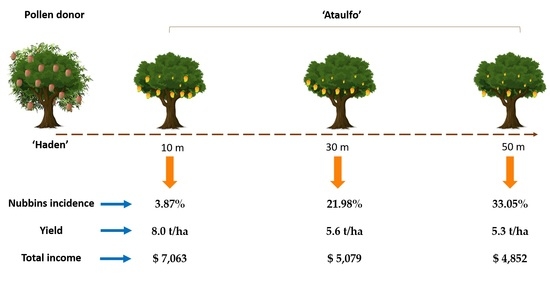Spatial Proximity of ‘Ataulfo’ to ‘Haden’ Cultivar Increases Mango Yield and Decreases Incidence of Nubbins
Abstract
1. Introduction
2. Materials and Methods
2.1. Study Site
2.2. Study Species
2.3. Incidence of Nubbins and Production of Fruits
2.4. Quality of Commercial Fruits
2.5. Yield and Economic Income
2.6. Orchards of ‘Ataulfo’ without ‘Haden’
2.7. Statistical Analyses
3. Results
3.1. Incidence of Nubbins and Production of Fruits
3.2. Quality of Commercial Fruits
3.3. Yield and Economic Income
4. Discussion
5. Conclusions
Supplementary Materials
Author Contributions
Funding
Data Availability Statement
Acknowledgments
Conflicts of Interest
References
- Dutta, S.K.; Srivastav, M.; Chaudhary, R.; Lal, K.; Patil, P.; Singh, S.K.; Singh, A.K. Low temperature storage of mango (Mangifera indica L.) pollen. Sci. Hortic. 2013, 161, 193–197. [Google Scholar] [CrossRef]
- Geslin, B.; Oddie, M.; Folschweiller, M.; Legras, G.; Seymour, C.L.; van Veen, F.J.F.; Thébault, E. Spatiotemporal changes in flying insect abundance and their functional diversity as a function of distance to natural habitats in a mass flowering crop. Agric. Ecosyst. Environ. 2016, 229, 21–29. [Google Scholar] [CrossRef]
- Menzel, C.M.; Le Lagadec, M.D. Can the productivity of mango orchards be increased by using high-density plantings? Sci. Hortic. 2017, 219, 222–263. [Google Scholar] [CrossRef]
- Infante, F.; Quilantán, J.; Rocha, F.; Esquinca, H.; Castillo, A.; Ibarra Nuñez, G.; Palacio, V. Mango Ataulfo: Orgullo chiapaneco. Biodiversitas 2011, 96, 1–5. [Google Scholar]
- Salazar-García, S.; Álvarez-Bravo, A.; Ibarra-Estrada, M.E.; González-Valdivia, J.; Medina-Torres, R. Presencia de fruto partenocárpico en mango ‘Ataúlfo’ y su relación con la temperatura ambiental y tratamientos de fertilización. Rev. Mex. Ciencias Agrícolas 2016, 8, 2615. [Google Scholar] [CrossRef][Green Version]
- Pérez-Barraza, M.H.; Vázquez-Valdivia, V.; Osuna-García, J.A. Incidencia de frutos partenocárpicos en Mango ‘Ataulfo’ en huertos comerciales de Nayarit. Rev. Chapingo Ser. Hortic. 2007, 13, 149–156. [Google Scholar]
- Leyva-Mayo, A.; Noriega-Cantú, D.H.; Pérez-Barraza, M.H.; González-Mateos, R.; Hernandez-Pereyda, J. Distribución geográfica de frutos partenocárpicos en mango cv. ‘Ataúlfo’ en la Costa de Guerrero. Foro Estud. Sobre Guerr. 2016, 2, 1–5. [Google Scholar]
- Pérez-Barraza, M.H.; Vázquez-Valdivia, V.; Osuna-García, J.A.; Urías-López, M.A. Increase on set and size parthenocarpic fruit in ‘Ataulfo’ mango with growth regulators. Rev. Chapingo Ser. Hortic. 2009, 15, 183–188. [Google Scholar] [CrossRef]
- Patiño-Rodríguez, O.; Bello-Pérez, L.A.; Agama-Acevedo, E.; Pacheco-Vargas, G. Pulp and peel of unripe stenospermocarpic mango (Mangifera indica L. cv Ataulfo) as an alternative source of starch, polyphenols and dietary fibre. Food Res. Int. 2020, 138, 109719. [Google Scholar] [CrossRef] [PubMed]
- Gehrke-Vélez, M.; Castillo-Vera, A.; Ruiz-Bello, C.; Moreno-Martinez, J.L.; Moreno-Basurto, G. Delayed self-incompatibility causes morphological alterations and crop reduction in “Ataúlfo” mango (Mangifera indica L.). New Zeal. J. Crop Hortic. Sci. 2012, 40, 215–227. [Google Scholar] [CrossRef]
- Mukherjee, S.K.; Singh, R.N.; Majumder, P.K.; Sharma, D.K. Present position regarding breeding of mango (Mangifera indica L.) in India. Euphytica 1968, 17, 462–467. [Google Scholar] [CrossRef]
- Sharma, D.K.; Singh, R.N. Self-incompatibility in mango (Mangifera indica L.). Hortic. Res. 1970, 10, 108–118. [Google Scholar]
- Ram, S.; Bist, L.D.; Lakhanpal, S.C.; Jamwal, I.S.; Pant, G.B. Search of suitable pollinizers for mango cultivars. Acta Hortic. 1976, 57, 253–263. [Google Scholar] [CrossRef]
- Pinto, A.C. de Q.; Saúco, V.G.; Mitra, S.K.; Ferreira, F.R. Mango Propagation. Rev. Bras. Frutic. 2018, 40, 1–13. [Google Scholar]
- Mendoza-Herrera, C.; Rosas-Quijano, R.; Vazquez-Ovando, A.; Galvez-Lopez, D. Retos y controversias del mango Ataulfo. Rev. Mex. Ciencias Agrícolas 2020, 11, 1633–1645. [Google Scholar] [CrossRef]
- MacInnis, G.; Forrest, J.R.K. Field design can affect cross-pollination and crop yield in strawberry (Fragaria x ananassa D.). Agric. Ecosyst. Environ. 2020, 289, 106738. [Google Scholar] [CrossRef]
- Quinet, M.; Jacquemart, A.L. Cultivar placement affects pollination efficiency and fruit production in European pear (Pyrus communis) orchards. Eur. J. Agron. 2017, 91, 84–92. [Google Scholar] [CrossRef]
- Buccheri, M.; Di Vaio, C. Relationship Among Seed Number, Quality, and Calcium Content in Apple Fruits. J. Plant Nutr. 2005, 27, 1735–1746. [Google Scholar] [CrossRef]
- Matsumoto, S.; Eguchi, T.; Maejima, T.; Komatsu, H. Effect of distance from early flowering pollinizers “Maypole” and “Dolgo” on “Fiji” fruit set. Sci. Hortic. 2008, 117, 151–159. [Google Scholar] [CrossRef]
- Dag, A.; Degani, C.; Gazit, S.; Smith, R.H. Gene flow in mango orchards and its impact on yield. Acta Hortic. 2009, 820, 347–350. [Google Scholar] [CrossRef]
- Dag, A.; Eisenstein, D.; Gazit, S.; El-Batsri, R.; Degani, C. Effect of Pollnizer Distance and Selective Fruitlet Abscission on Outcrossing Rate and Yield in ´Tommy Atkins´ Mango. J. Am. Soc. Hortic. Sci. 1998, 123, 618–622. [Google Scholar] [CrossRef]
- Sáez, A.; di Virgilio, A.; Tiribelli, F.; Geslin, B. Simulation models to predict pollination success in apple orchards: A useful tool to test management practices. Apidologie 2018, 49, 551–561. [Google Scholar] [CrossRef]
- Free, J.B. The Effect of Distance from Pollinizer Varieties on the Fruit Set on Trees in Plum and Apple Orchards. J. Hortic. Sci. 1962, 37, 262–271. [Google Scholar] [CrossRef]
- Free, J.B.; Spencer-Booth, Y. The Foraging Behaviour of Honey-Bees in an Orchard of Dwarf Apple Trees. J. Hortic. Sci. 1964, 39, 78–83. [Google Scholar] [CrossRef]
- Nishio, S.; Takada, N.; Terakami, S.; Kato, H.; Inoue, H.; Takeuchi, Y.; Saito, T. Estimation of effective pollen dispersal distance for cross-pollination in chestnut orchards by microsatellite-based paternity analyses. Sci. Hortic. 2019, 250, 89–93. [Google Scholar] [CrossRef]
- Sánchez-Estrada, A.; Cuevas, J. Pollination designs in ‘Manzanillo’ olive orchards. Sci. Hortic. 2020, 261. [Google Scholar] [CrossRef]
- Sharma, H.K.; Gupta, J.K.; Thakur, J.R. Effect of bee pollination and polliniser proportion on apple productivity. Acta Hortic. 2004, 662, 451–454. [Google Scholar] [CrossRef]
- Jackson, J.F. Gene flow in pollen in commercial almond orchards. Sex. Plant Reprod. 1996, 9, 367–369. [Google Scholar] [CrossRef]
- Kron, P.; Husband, B.C.; Kevan, P.G.; Belaoussoff, S. Factors affecting pollen dispersal in high-density apple orchards. HortScience 2001, 36, 1039–1046. [Google Scholar] [CrossRef]
- Free, J.B. The Behaviour of Honeybees Visiting Flowers of Fruit Trees. J. Anim. Ecol. 1960, 29, 385. [Google Scholar] [CrossRef]
- Cranmer, L.; McCollin, D.; Ollerton, J. Landscape structure influences pollinator movements and directly affects plant reproductive success. Oikos 2012, 121, 562–568. [Google Scholar] [CrossRef]
- Brittain, C.; Williams, N.; Kremen, C.; Klein, A.M. Synergistic effects of non-Apis bees and honey bees for pollination services. Proc. R. Soc. B Biol. Sci. 2013, 280, 1–7. [Google Scholar] [CrossRef] [PubMed]
- SIAP (Sistema de Información Agropecuaria). Módulo Agrícola. Sistema de Información Agroalimentaria de Consulta Nueva Generación (SIACON-NG). 2019. Available online: https://www.gob.mx/siap/documentos/siacon-ng-161430. (accessed on 20 October 2020).
- INEGI (Instituto Nacional de Estadística y Geografía). Prontuario de Información Geográfica Municipal de los Estados Unidos Mexicanos; Clave Geoestadística 12057; INEGI: Técpan de Galeana, Guerrero, 2009; Volume 9.
- Tangtorwongsakul, P.; Warrit, N.; Gale, G.A. Effects of landscape cover and local habitat characteristics on visiting bees in tropical orchards. Agric. For. Entomol. 2018, 20, 28–40. [Google Scholar] [CrossRef]
- Simba, L.D.; Foord, S.H.; Thébault, E.; van Veen, F.J.F.; Joseph, G.S.; Seymour, C.L. Indirect interactions between crops and natural vegetation through flower visitors: The importance of temporal as well as spatial spillover. Agric. Ecosyst. Environ. 2018, 253, 148–156. [Google Scholar] [CrossRef]
- Adame-Arroyo, A.; Rosas-Guerrero, V.; Alemán-Figueroa, L.; Lucas-García, R.; Severiano-Galeana, F.; Ramirez-Ramirez, M.G. Compatibility of mango ‘Ataulfo’ with cultivar ‘Haden’: Implications in quality of commercial fruits. Status (manuscript in preparation).
- Helaly, M.N.; El-Sheery, N.I.; El-Hoseiny, H.; Rastogi, A.; Kalaji, H.M.; Zabochnicka-Świątek, M. Impact of treated wastewater and salicylic acid on physiological performance, malformation and yield of two mango cultivars. Sci. Hortic. 2018, 233, 159–177. [Google Scholar] [CrossRef]
- Avilán, L.; Marín, R.C.; Rodriguez, M. Crecimiento, Floración y producción del mango sometidos a diferentes tratamientos en plantaciones de alta densidad. Agron. Trop. 2001, 51, 29–47. [Google Scholar]
- SNIIM (Sistema Nacional de Información e Integración de Mercados). 2020. Available online: http://www.economia-sniim.gob.mx/nuevo/Home.aspx (accessed on 20 October 2020).
- Bates, D.; Maechler, M.; Bolker, B.; Walker, S.; Christensen, R.H.B.; Singmann, H. lme4: Linear Mixed-Effects Models Using Eigen and S4. R Package Version 1.1-12. 2016. Available online: www.CRAN.R-project.org/package=lme4 (accessed on 15 June 2020).
- R Core Team. R: A Language and For, for Statistical Computing. R Foundation Statistical Computing; R Core Team: Vienna, Austria, 2019; Volume 10, pp. 11–18. [Google Scholar]
- Lüdecke, D. Ggeffects: Tidy Data Frames of Marginal Effects from Regression Models. J. Open Source Softw. 2018, 3, 772. [Google Scholar] [CrossRef]
- Gehrke Vélez, M. Reflexiones sobre problemas de biología reproductiva del mango Ataúlfo en el Soconusco, Chiapas. Tecnol. en Marcha 2008, 21, 174–183. [Google Scholar]
- Hernández-Maruri, J.A.; Castillo-González, A.M.; Pérez-Barraza, M.H.; Avitia-García, E.; Trejo-Téllez, L.I.; Osuna-García, J.A.; García-Mateos, R. Fertilización con boro y su relación con la producción de frutos sin semilla en mango ’Ataulfo’. Rev. Mex. Ciencias Agrícolas 2015, 6, 1757–1768. [Google Scholar] [CrossRef][Green Version]
- Lakshminarayana, S.; Hernandez Aguilar, P. Effect of Orchard Heating in Reducing Parthenocarpic Fruits in “Haden” mango. Fla. State Hortic. Soc. 1975, 88, 502–505. [Google Scholar]
- Lim, T.K.; Luders, L.; Poff ley, M. Studies on fruit deformity and nubbins in Irwin mango. In Proceedings of the International Conference on Tropical Fruit, Kuala Lumpur, Malaysia, 23–26 July 1996; pp. 287–298. [Google Scholar]
- Sukhvibul, N.; Whiley, A.W.; Smith, M.K. Effect of temperature on seed and fruit development in three mango (Mangifera indica L.) cultivars. Sci. Hortic. 2005, 105, 467–474. [Google Scholar] [CrossRef]
- Whiley, A.W.; Saranah, J.B.; Rasmussen, T.S.; Winston, E.C.; Wolstenholme, B.N. Effect of temperature on ten mango cultivars with relevance to production in Australia. In Proceedings of the Fourth Australasian Conference on Tree and Nut Crops, Lismore, New South Wales, 14–20 August 1988; pp. 176–185. [Google Scholar]
- Weather Spark (The Typical Weather Anywhere on Earth). 2020. Available online: https://weatherspark.com/ (accessed on 20 October 2020).
- Chautá-Mellizo, A.; Campbell, S.A.; Bonilla, M.A.; Thaler, J.S.; Poveda, K. Effects of natural and artificial pollination on fruit and offspring quality. Basic Appl. Ecol. 2012, 13, 524–532. [Google Scholar] [CrossRef]
- Degani, C.; Goldring, A.; Adato, I.; El-Batsri, R. Pollen parent effect on outcrossing rate, yield, and fruit characteristics of ‘floridian’ and ‘mauritius’ lychee. J. Am. Soc. Hortic. Sci. 1990, 25, 109–114. [Google Scholar] [CrossRef]
- Rosati, A.; Zipanćič, M.; Caporali, S.; Paoletti, A. Fruit set is inversely related to flower and fruit weight in olive (Olea europaea L.). Sci. Hortic. 2010, 126, 200–204. [Google Scholar] [CrossRef]
- Carisio, L.; Díaz, S.S.; Ponso, S.; Manino, A.; Porporato, M. Effects of pollinizer density and apple tree position on pollination efficiency in cv. Gala. Sci. Hortic. 2020, 273. [Google Scholar] [CrossRef]
- Melathopoulos, A.P.; Cutler, G.C.; Tyedmers, P. Where is the value in valuing pollination ecosystem services to agriculture? Ecol. Econ. 2015, 109, 59–70. [Google Scholar] [CrossRef]
- Tamburini, G.; Bommarco, R.; Kleijn, D.; van der Putten, W.H.; Marini, L. Pollination contribution to crop yield is often context-dependent: A review of experimental evidence. Agric. Ecosyst. Environ. 2019, 280, 16–23. [Google Scholar] [CrossRef]
- Eeraerts, M.; Vanderhaegen, R.; Smagghe, G.; Meeus, I. Pollination efficiency and foraging behaviour of honey bees and non-Apis bees to sweet cherry. Agric. For. Entomol. 2019, 22, 75–82. [Google Scholar] [CrossRef]
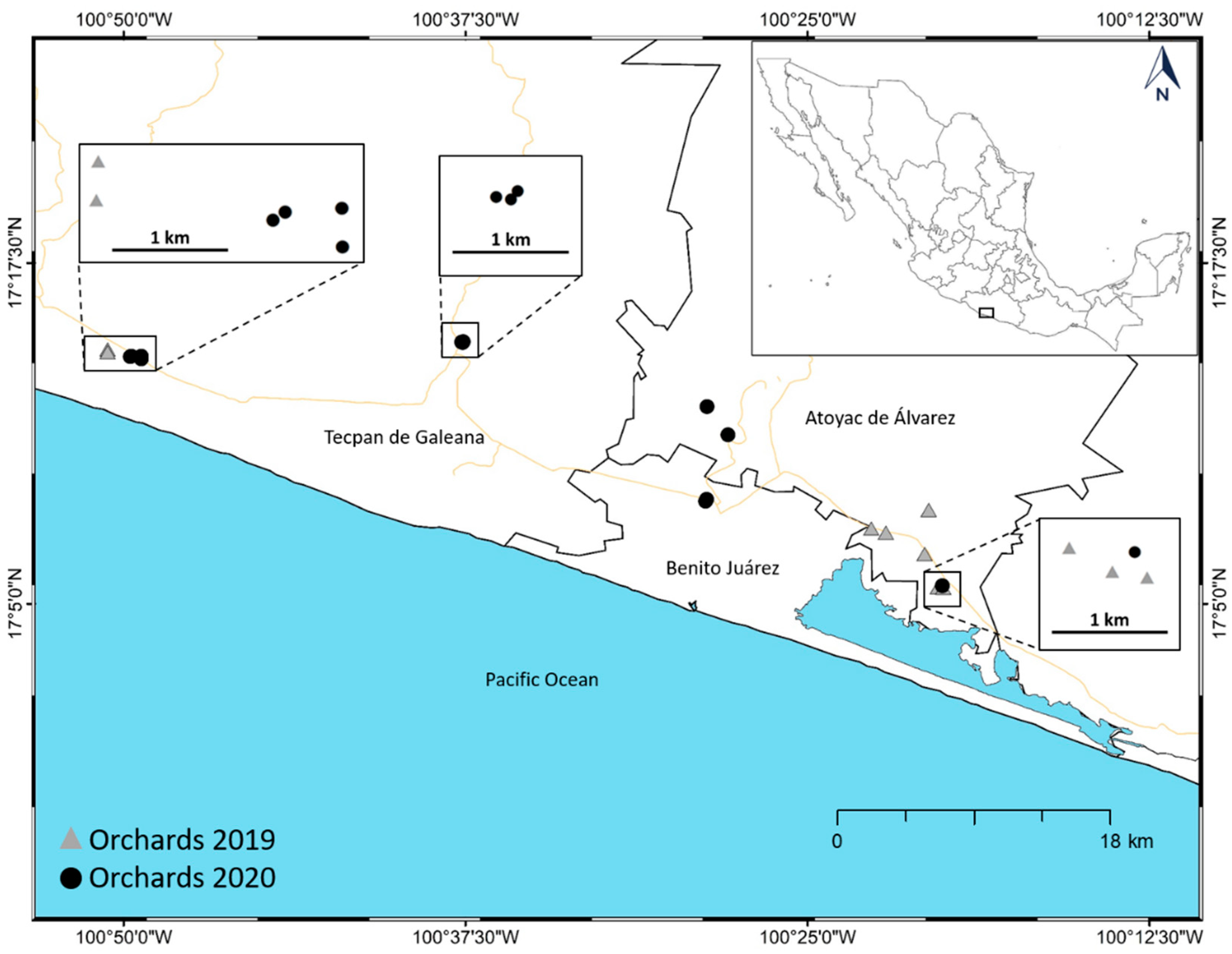
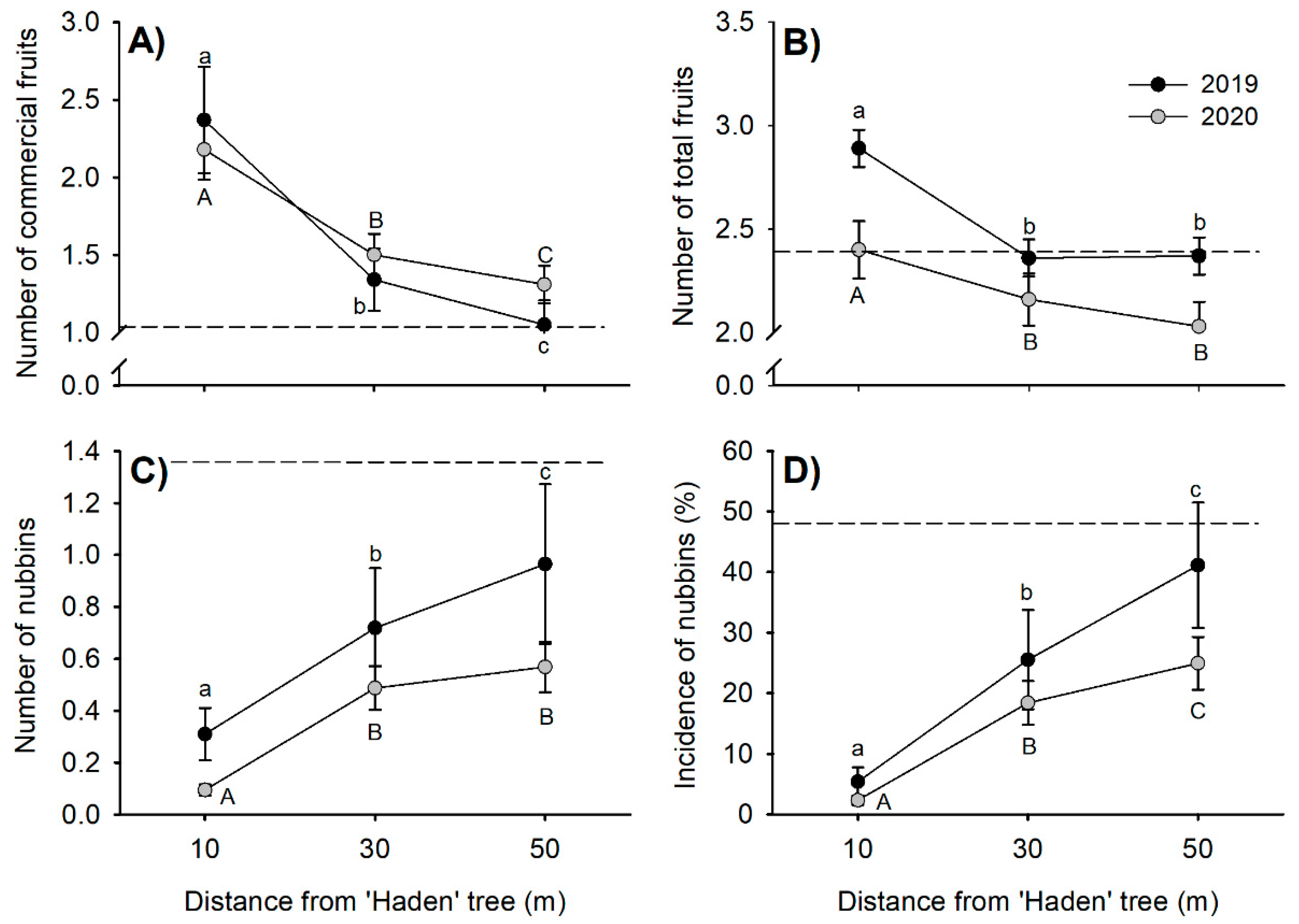
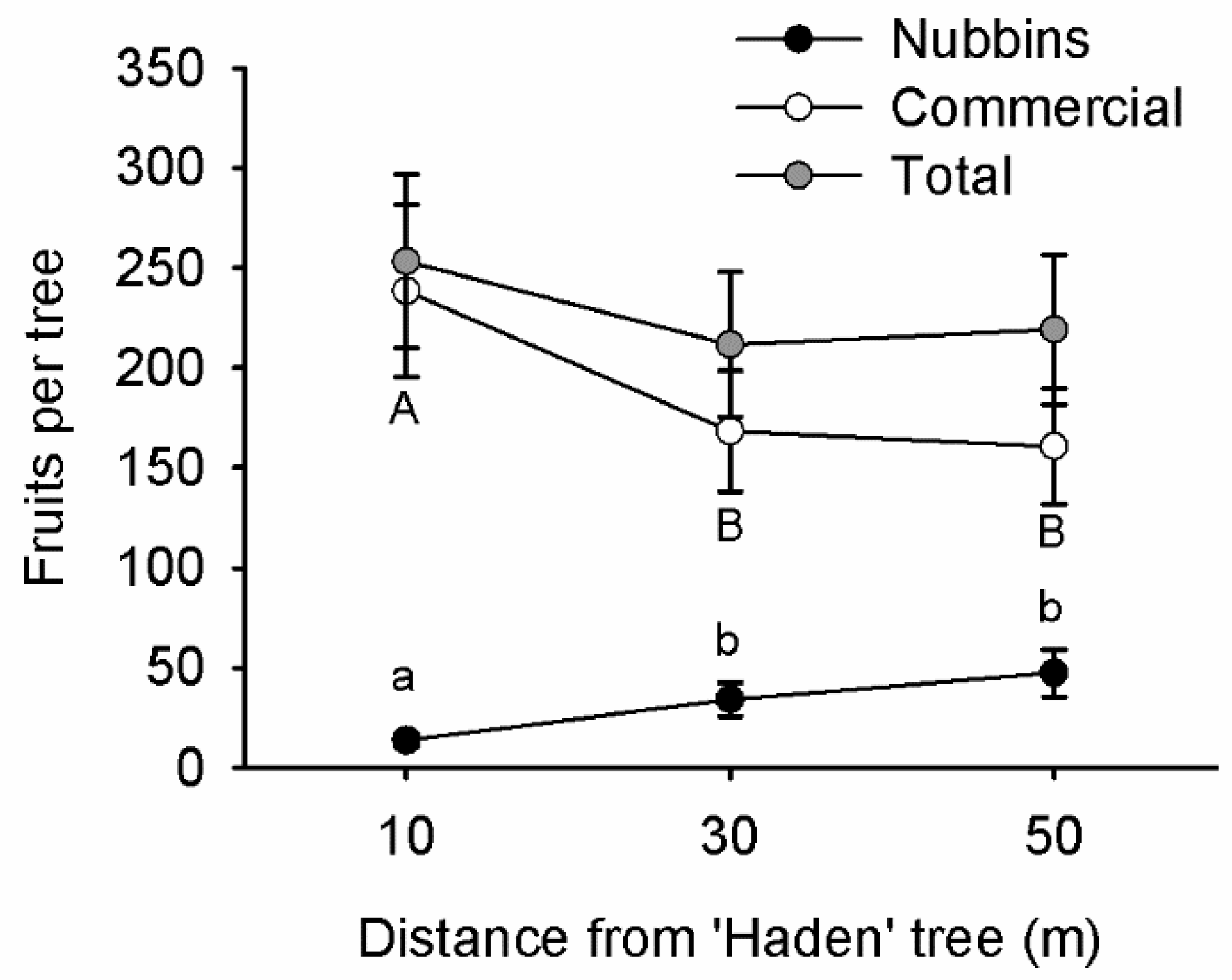
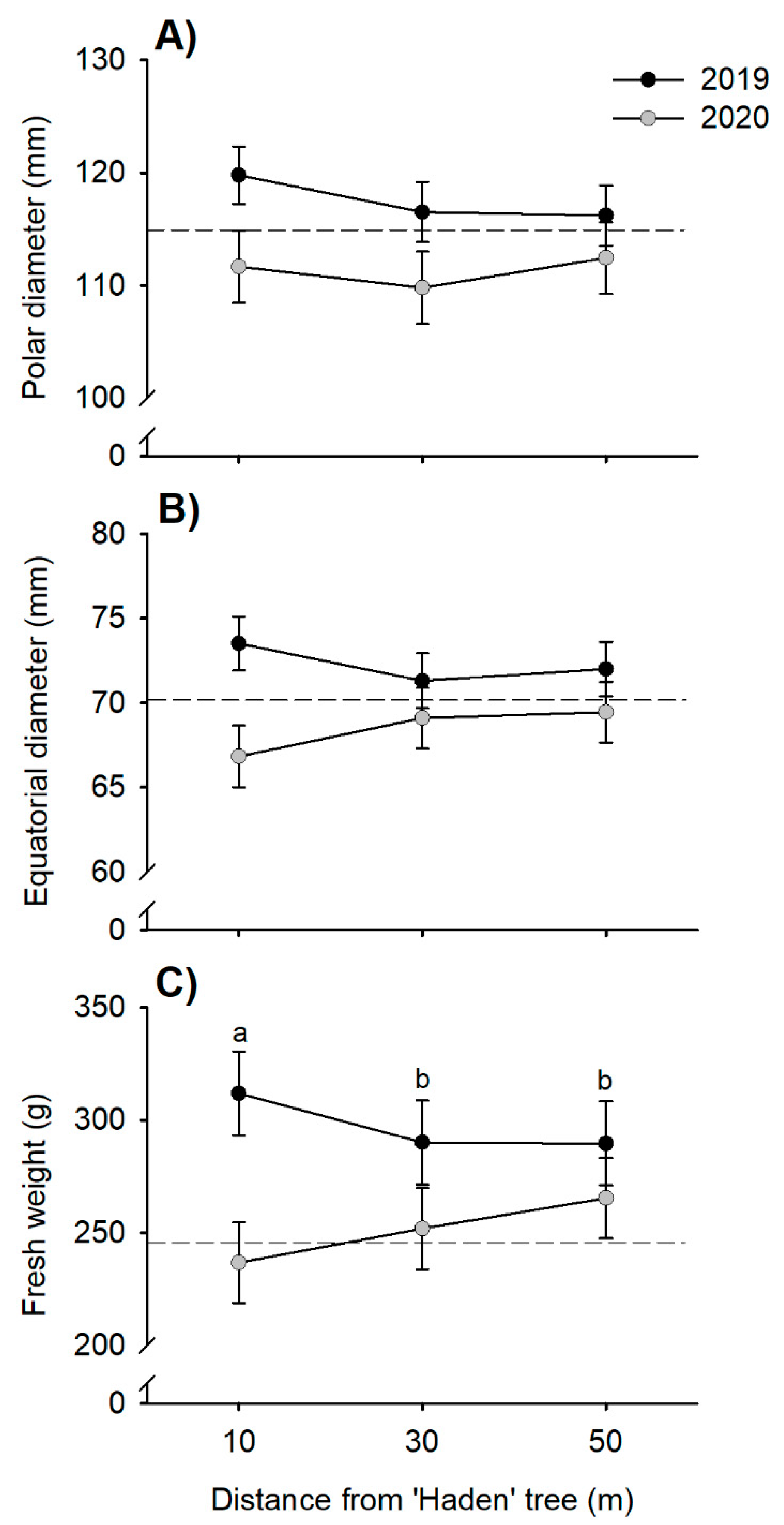
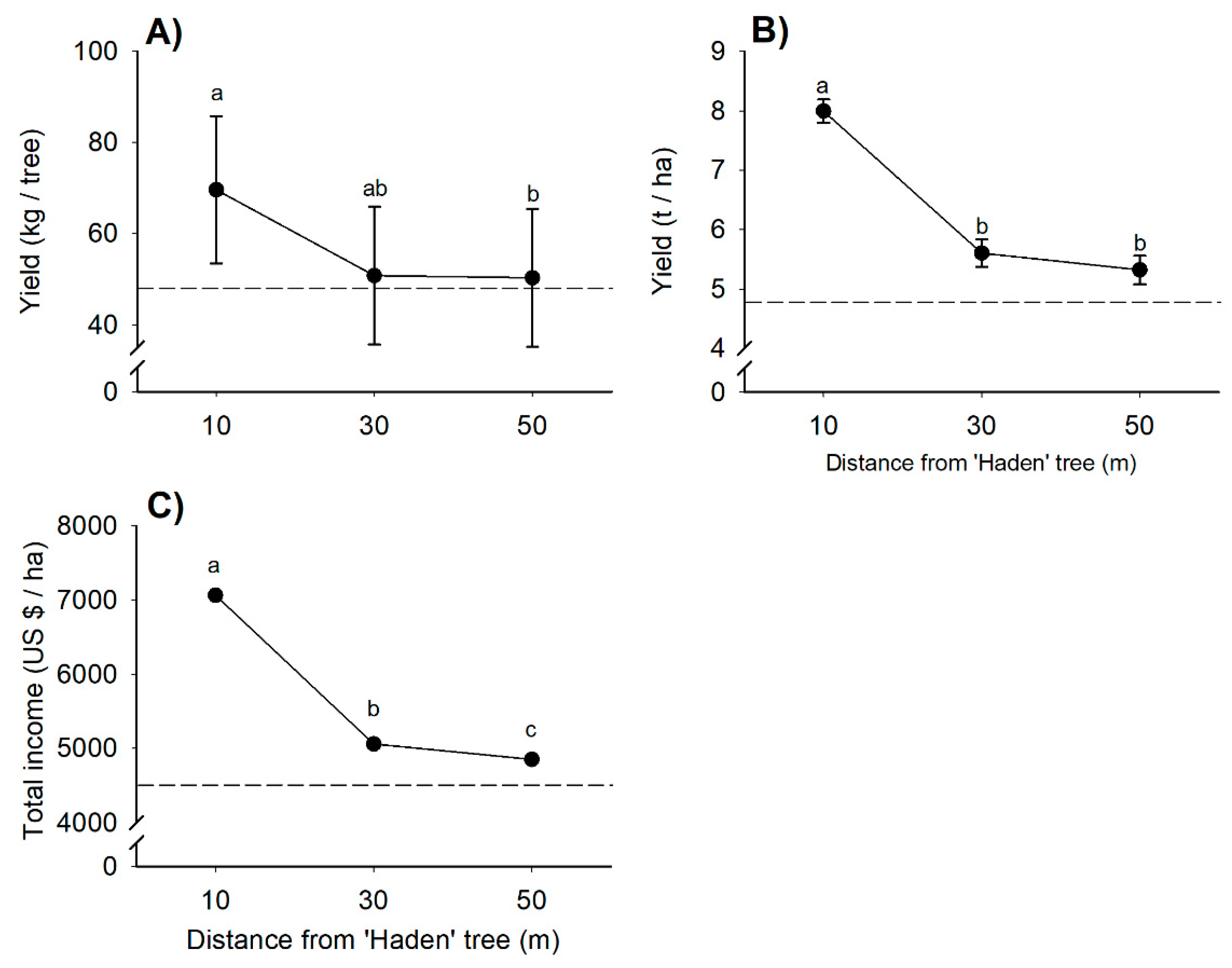
Publisher’s Note: MDPI stays neutral with regard to jurisdictional claims in published maps and institutional affiliations. |
© 2021 by the authors. Licensee MDPI, Basel, Switzerland. This article is an open access article distributed under the terms and conditions of the Creative Commons Attribution (CC BY) license (http://creativecommons.org/licenses/by/4.0/).
Share and Cite
Lucas-García, R.; Rosas-Guerrero, V.; Alemán-Figueroa, L.; Almazán-Núñez, R.C.; Violante-González, J.; Kuk-Dzul, J.G. Spatial Proximity of ‘Ataulfo’ to ‘Haden’ Cultivar Increases Mango Yield and Decreases Incidence of Nubbins. Agronomy 2021, 11, 450. https://doi.org/10.3390/agronomy11030450
Lucas-García R, Rosas-Guerrero V, Alemán-Figueroa L, Almazán-Núñez RC, Violante-González J, Kuk-Dzul JG. Spatial Proximity of ‘Ataulfo’ to ‘Haden’ Cultivar Increases Mango Yield and Decreases Incidence of Nubbins. Agronomy. 2021; 11(3):450. https://doi.org/10.3390/agronomy11030450
Chicago/Turabian StyleLucas-García, Rodrigo, Víctor Rosas-Guerrero, Lorena Alemán-Figueroa, R. Carlos Almazán-Núñez, Juan Violante-González, and José Gabriel Kuk-Dzul. 2021. "Spatial Proximity of ‘Ataulfo’ to ‘Haden’ Cultivar Increases Mango Yield and Decreases Incidence of Nubbins" Agronomy 11, no. 3: 450. https://doi.org/10.3390/agronomy11030450
APA StyleLucas-García, R., Rosas-Guerrero, V., Alemán-Figueroa, L., Almazán-Núñez, R. C., Violante-González, J., & Kuk-Dzul, J. G. (2021). Spatial Proximity of ‘Ataulfo’ to ‘Haden’ Cultivar Increases Mango Yield and Decreases Incidence of Nubbins. Agronomy, 11(3), 450. https://doi.org/10.3390/agronomy11030450






